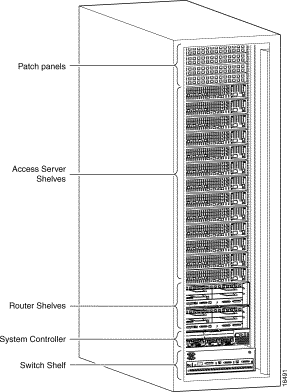|
|

Your Cisco AccessPath Model 531 system was delivered in a configuration designed to meet your specific needs. Each configuration is built around a Cisco-specified switching and routing infrastructure, which you can expand as your call density demands increase.
You can expand your incoming call or data handling capacity by increasing the number of Primary Rate Interfaces (PRIs) in your system.
Figure 1-1 shows a fully populated Cisco AccessPath-TS3 Model 531 Integrated Access System (single density) in a High-End configuration.
Figure 1-2 shows a fully populated Cisco AccessPath-TS3 Model 531 Integrated Access System (double density) in a High-End configuration.
Figure 1-3 shows a fully populated Cisco AccessPath-VS3 Packet Telephony Concentrator in a High-End configuration.
Whenever you add or remove Cisco AccessPath Model 531 system devices such as Access Server Shelves, you must update the software configurations on your Cisco AccessPath Model 531 system devices.
The AccessPath-TS3 Configurator or AccessPath-VS3 Configurator should be used to update the configurations on your Cisco AccessPath Model 531 system devices. See the following guides for detailed descriptions of the software configurator programs:
Hardware upgrade options consist of upgrading from one configuration to another, or upgrading within an existing configuration.
When you upgrade from one configuration to another, you typically add infrastructure devices such as a Router Shelf.
One upgrade scenario (upgrading to a High-End/Extended Cabinet configuration) is unique in its requirements. In this case you will add a second cabinet, Access Server Shelves, and cabinet interconnect cables that will connect the components of the primary and secondary cabinets.



There are four standard configurations of the Cisco AccessPath-TS3 Model 531 system. The four standard configurations are:
Each configuration contains a switched infrastructure, using different combinations of Cisco's dual Ethernet switch module and the Cisco Catalyst 5002 Switch Shelf. The system is designed around infrastructure devices (Switch Shelf, Router Shelf, and System Controller) that support system growth.
All Cisco AccessPath-TS3 Model 531 system configurations include:
The Cisco AccessPath-TS3 Model 531 system Entry-level configuration supports up to 56 PRIs. This configuration's primary data paths run from the network access server (NAS) ports to the primary dual Ethernet switch module using full duplex auto-sensing 10BaseT ports. The switch uses Fast Ethernet (100BaseT) to transmit data to the Router Shelf.
The Entry-level configuration consists of the following components:
The Entry-level configuration is the base system configuration for the Cisco AccessPath-TS3 Model 531 system. You can upgrade within its defined parameters by adding Access Server Shelves until you reach a total of seven, or upgrade to the Midrange configuration by adding a Switch Shelf.
The Midrange configuration for the Cisco AccessPath-TS3 Model 531 system supports up to 88 PRIs. This configuration is characterized by the addition of the Cisco Catalyst 5002 switch to the switching infrastructure.
The Midrange configuration includes the following components:
The High-End configuration for the Cisco AccessPath-TS3 Model 531 system supports up to 112 PRIs. This configuration features the addition of a second Router Shelf to the switching infrastructure. The addition provides for greater processing efficiency and system-level failover and allows you to increase the Access Server Shelf limit of the Midrange configuration to 13.
The High-End configuration includes the following components:
The High-End and High-End/Extended Cisco AccessPath-TS3 Model 531 system configurations contain identical infrastructures. The difference between the two configurations is that the High-End/Extended configuration adds a second cabinet to the configuration. This physical change lets you add up to 8 Access Server shelves, supporting up to 168 PRIs.
The High-End/Extended configuration includes the following components:
There are three standard configurations of the Cisco AccessPath-VS3 Packet Telephony Concentrator. The three standard configurations are:
The Midrange configuration for the Cisco AccessPath-VS3 Packet Telephony Concentrator supports up to 44 PRIs.
The Midrange configuration includes the following components:
The High-End configuration for the Cisco AccessPath-VS3 Packet Telephony Concentrator supports up to 28 PRIs. This configuration features the addition of a second Router Shelf to the switching infrastructure. The addition provides for greater processing efficiency and system-level failover and allows you to increase the Access Server Shelf limit to 14.
The High-End configuration includes the following components:
The High-End/Extended configuration adds a second cabinet to the Extended configuration. This physical change allows the addition of 7 Access Server Shelves, supporting up to 84 PRIs.
The High End/extended configuration includes the following components:
Another variation of upgrading the Cisco AccessPath Model 531 system is to upgrade within a given configuration. This intra-configuration hardware upgrade involves the addition of Access Server Shelves to the system without changing the switching infrastructure.
The following list shows the maximum number of Access Server Shelf supported by each configuration:
Cisco AccessPath-TS3 Model 531 system
Cisco AccessPath-VS3 Packet Telephony Concentrator
Remember, these guidelines when upgrading within any of the Cisco AccessPath Model 531 system configurations:
Cisco AccessPath Model 531 systems may contain Access Server Shelves with 4- or 8-PRI capabilities. If you add an 8-PRI Access Server Shelf to a system designed for 4-PRI Access Servers, you must do the following:
![]()
![]()
![]()
![]()
![]()
![]()
![]()
![]()
Posted: Tue Jul 23 10:03:39 PDT 2002
All contents are Copyright © 1992--2002 Cisco Systems, Inc. All rights reserved.
Important Notices and Privacy Statement.